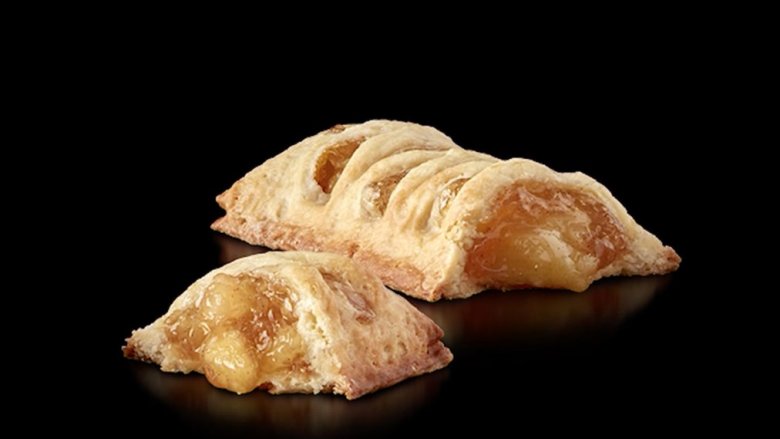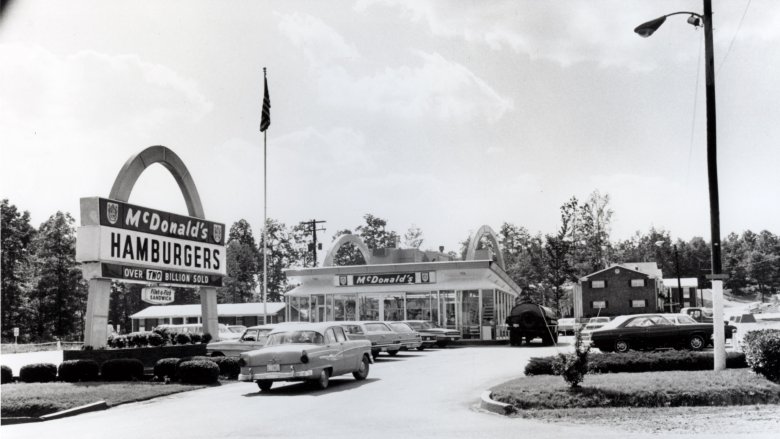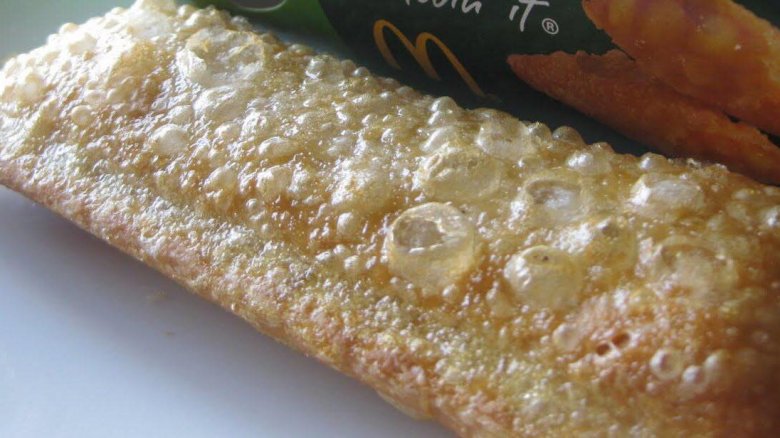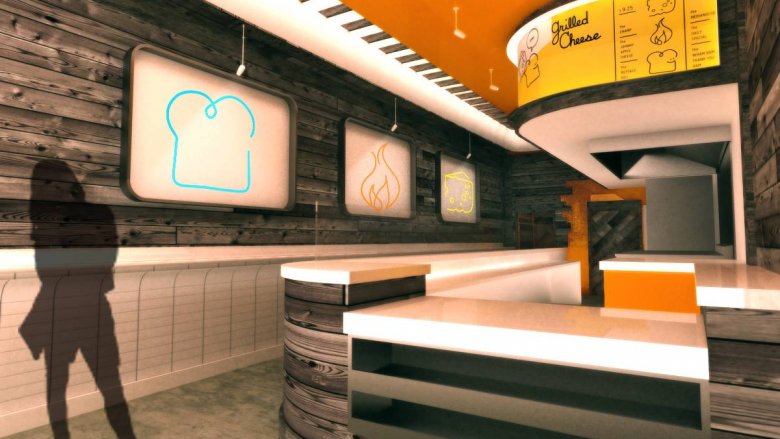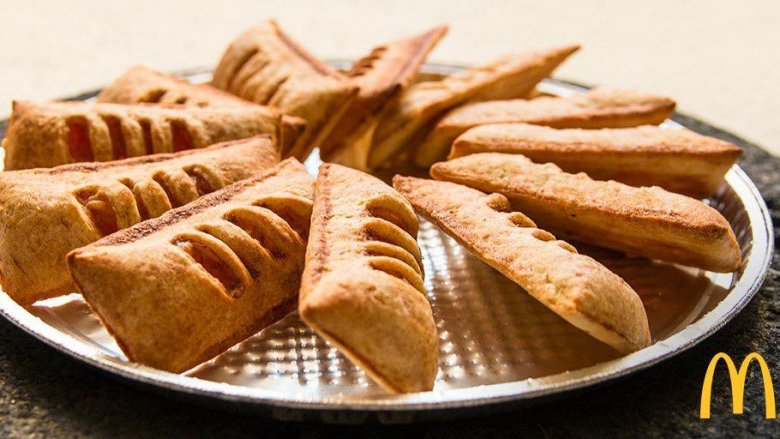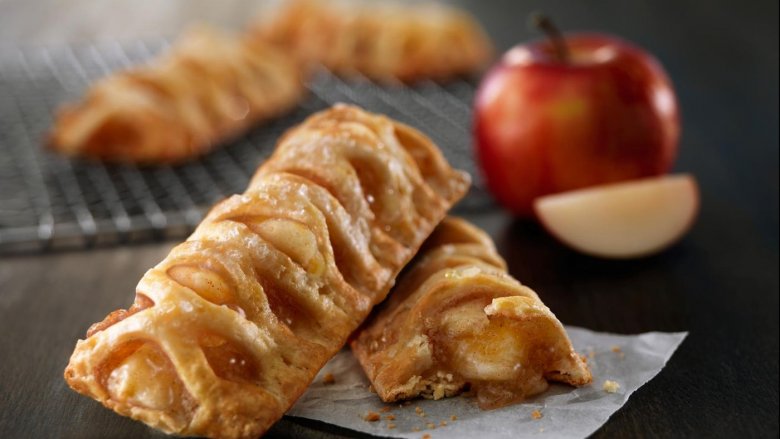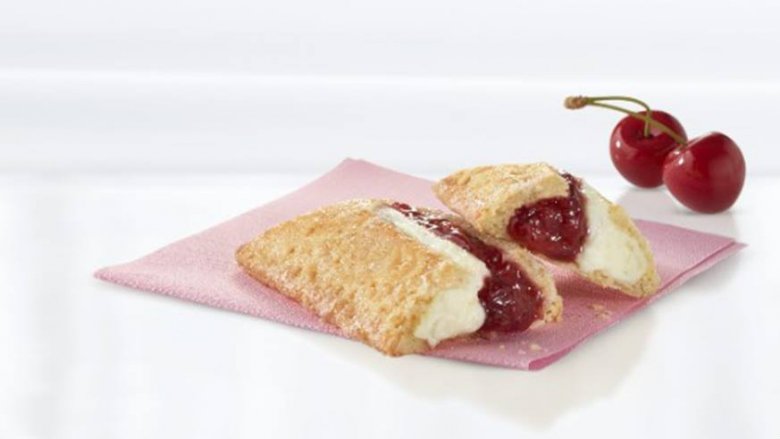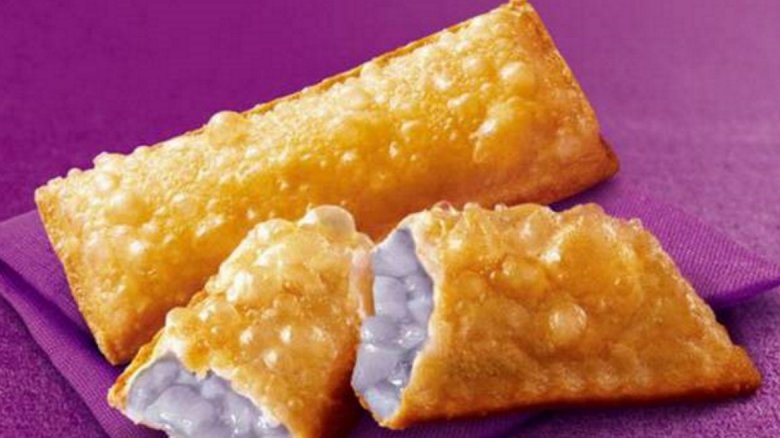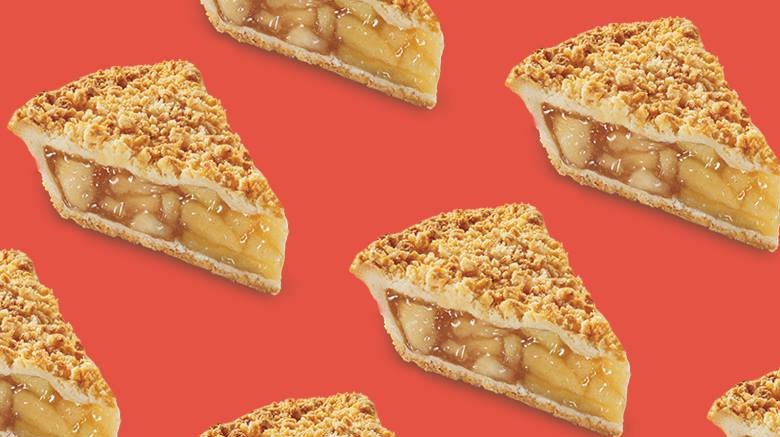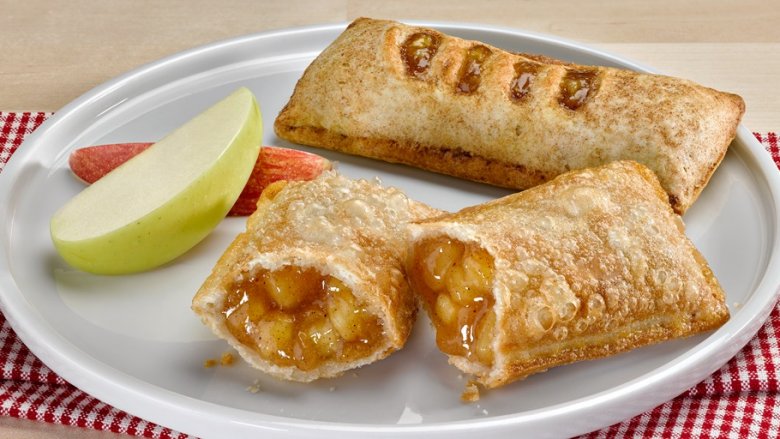The Truth About McDonald's Famous Hot Apple Pie
Quick-service, ubiquitous, and born from humble origins, McDonald's is a bright yellow symbol of American culture. Brought here from abroad, influenced by immigrant cultures, and spread around the world through globalization, the apple pie is closely tied to American identity, too.
So if nothing says American capitalism like McDonald's, and there's nothing as American as apple pie, could we then conclude that McDonald's apple pies are among the most American of all apple pies?
A bold claim, perhaps, but the McDonald's apple pie has managed to remain a staple American fast-food dessert for more than half a century. The very first dessert officially offered at McDonald's nationwide, the iconic apple pie has lived on, even as menu items like the McPizza, Fish McBites, and McSpaghetti came and went. It's persevered through countless makeovers — most notably, its fateful, much-protested transformation from fried to baked back in the '90s.
But as time-honored and beloved as the little pie in a cardboard pouch has become, there are secrets hidden beneath that doughy crust you may not be aware of. Read on to learn the truth about McDonald's famous apple pies.
The original recipe was based on someone's mom's apple pies
It was the early 1960s, and McDonald's founder Ray Kroc was in a pickle. His hamburgers, cheeseburgers, and french fries, by all accounts, had been a wild success. But his experiments with kolackies, brownies, strawberry shortcakes, and other short-lived attempts at dessert? Not so much.
As Kroc begged the muses of McDonald's to grant him dessert inspiration, a McDonald's restaurant owner in Tennessee decided to ask his mother. As a child growing up in Knoxville, Litton Cochran had loved the tiny fried apple pies his mom used to cook for him after school. After opening Knoxville's first McDonald's in 1960, Cochran hired his mom and sister as dessert chefs to make the apple pies he loved so well. Pulling from Mrs. Cochran's original recipe, they fried turnover-style apple pies until they were crisp and golden, then tucked them into a cardboard pouch. The pies grew to be so popular, the family had to bring in a corporate supplier.
It wasn't long before the warm aroma of the Knoxville McDonald's apple pies reached Kroc's nose. The dessert was introduced to the official McDonald's menu in 1968 and hit McDonald's stores across the U.S. by the 1970s.
The switch from fried to baked sparked national outrage
Everything was chugging along fine for McDonald's hot apple pie until the early 90s. Then, on one earth-shaking day in 1992, McDonald's stopped deep-frying its apple pies and switched to baking.
The exact reason behind this drastic, some-would-call foolish move is still debated. Some hypothesize the change from deep-frying to baked was intended to make the pie healthier. Others speculate that McDonald's wanted to reduce the risk of the legal battle that could ensue if a customer burned his or her tongue on the ultra-hot apple filling. But by switching to baked, McDonald's sacrificed the delicate, flaky crispiness of the deep-fried dough for something that was mushier, blander, and only marginally healthier.
Americans weren't going to let deep fried pies go without a fight. Fans would drive to far-flung locations to try and find outlier locations still serving fried apple pies. When the internet took off, people gathered in forums, begging fellow chatters for news of McDonald's deep-fried apple pie sightings. Today, you can still find petitions to bring back McDonald's fried apple pies and old lists of franchises that still offer them. So far, pleas to bring back the flaky pies have fallen on deaf ears — but the dream lives on in the hearts of nostalgic food bloggers and Tweeters.
... and gave rise to a tiny grassroots fried apple pie black market
When alcohol went off the menu at establishments across the US, speakeasies sprang up. When fried apple pie went off the menu at McDonald's, we got a fried apple pie black market — sort of.
A chef named Eric Greenspan stumbled into the McDonald's apple pie black market while at an unassuming food convention outside of Chicago. Greenspan was looking for packaging for the grilled cheese sandwiches he served at his Los Angeles restaurant, Greenspan's Grilled Cheese — like the ones McDonald's used for their fried apple pies, he explained.
As the chef recounted in an interview with L.A. Magazine, a salesman overheard him say the magic words "McDonald's fried apple pie" and revealed to Greenspan that he could get the original fried pies sold at McDonald's. The salesman worked with fast food restaurants across North America, and had a connection with the vendor that once supplied the fried pies to McDonald's (and still supplied them to Canadian locations).
Greenspan knew a golden, deep-fried opportunity when he saw one. He arranged for the black-market apple pies to be shipped to L.A., where he served them as "Throwback Apple Pies" for $3 at his restaurant. Greenspan has since closed his grilled cheese joint and moved on to other culinary inventions, but his heroic resurrection of McDonald's deep-fried pies will never be forgotten.
The apple pie just got a new, healthier makeover that also prompted public outcry
As if things couldn't get bad enough for devotees of the original, unhealthy fried apple pie, McDonald's gave the pie another healthy makeover in the fall of 2018. The new apple pie is part of McDonald's campaign to go all wholesome on us — a campaign that has included moves like removing cheese from cheeseburgers in the Happy Meals and removing artificial ingredients from their soft serve.
The 2018 version of the baked apple pie features 100-percent American sliced apples, instead of the diced mixture of yore. Instead of a cinnamon an sugar coating, the pie is topped with a lattice design and sugar sprinkles. The pie is spiced with cinnamon and actually includes more sugar than before: the old recipe had 13 grams of sugar, while the new one contains 16.
Fans have taken to Twitter to protest the new apple pie recipes. "McDonald's changed their apple pie crust & we should be rioting in the streets," tweeted one user.
"Where's the green box?" tweeted another. "Where's the apple PIE?!! The Franken-Strudel you have offered 2 nite is yet another example of big business sticking it to the common man!!"
They're made with six different types of American-grown apples
As noted, before McDonald's recent upgrade, the apple pie filling used to be a delicious — if not somewhat suspicious looking — gooey mix of diced apples. These apples could be from anywhere: Italy, New Zealand, an enchanted poison apple forest, etc.
Now, however, McDonalds has pledged to use only fresh, home-grown apples. Specifically, the franchise will offer pies made from six types of apples: Golden Delicious, Jonagold, Rome, Gala, Idared, and Fuji.
"Our new freshly baked Apple pie recipe is in line with other positive changes we have made," said a McDonald's spokesperson. "We removed, for example, artificial preservatives from our Chicken McNuggets and switched to real butter in our breakfast sandwiches because those changes matter to our guests."
You know what also matters to their guests? The taste. But that's none of our business...
There have been more than 40 different flavors of pies
In addition to apples, the company has experimented with more than 40 different fillings and seasonal flavors in pies over the last half century in the U.S. and beyond.
Not long after the apple pie was released, McDonald's launched its tart cousin, the cherry pie. Like the original apple pie, the cherry pie was fried, not baked. Word on the street is you can still find cherry pies at some franchises at certain times of the year.
McDonald's has been known to roll out a pumpkin-flavored pie as a limited-edition, seasonal flavor. The company has varied the recipe over the years, but a recent incarnation included pumpkin pie was half pumpkin pie filling, half creme.
During the Christmas season, McDonald's sometimes serves holiday pies at participating locations. Last year, the McDonald's holiday pie featured a vanilla custard filling baked into a sugar cookie-like crust and topped with colorful sprinkles.
Other siblings of the McDonald's apple pie that have come and gone and come again have included strawberry and creme, pineapple, and blueberry.
International McDonald's offer some pretty creative pie flavors
Once you start traveling the globe, McDonald's pies can get a lot more interesting.
The restaurant has thousands of locations in more than 100 countries, and often adapts menus to incorporate local ingredients and cuisines. In addition to mains and sides, international McDonald's have been known to offer pies inspired by local tastes, too.
Head to China, for instance, and you can find fried taro pie made with the thick, tuber root of taro plants (the pie has also been spotted in McDonald's locations in Hawaii). In McDonald's locations around Malaysia and South Korea, you can chow down on corn pie, which features a sweet blend of corn and custard.
If you make it to Japan, you can treat yourself to a bacon potato pie filled with a savory blend of bacon, potato, and onions. Head west, and you might be able to nab a ginger plum pie from the Ukraine or a banana pie in Brazil.
It inspired tons of copycat versions at other fast-food chains
What McDonald's does, competitor fast-food chains often follow. It comes as no surprise, then, that competitor restaurants like Burger King, Taco Bell, and Arby's offer their own apple pies. How do competitor apple pies stack up? Let's take a quick look:
-
Burger King's Dutch apple pie: Unlike most other fast-food apple pies that come in travel-friendly turnover form, Burger King's dutch apple pie is an actual slice of pie. The pie has the appealing appearance of being cut from an actual pie, but is decidedly less portable because of it.
-
Taco Bell's caramel apple empanada: Inspired by the traditional Latin american turnover, Taco Bell's caramel apple empanada is a pastry pocket of diced apples and brown sugar. The empanada is a little stingy on apples, but gets points for being only $1.
-
Arby's apple turnover: At 430 calories, Arby's apple turnover is the most caloric of all these pies. However, it also comes with the flakiest crust and a drizzle of vanilla icing.
-
Popeye's cinnamon apple pie: Popeye's cinnamon apple pie sets itself apart by being super cinnamon-y. The entire turnover is covered in a blanket of cinnamon, so you might prefer it if you happen to be really into cinnamon.
It's vegan!
Even before it got its second healthy makeover, the McDonald's apple pie was vegan. In fact, aside from drinks and dressing-less side salads, the apple pie was the only vegan option offered by McDonald's for a long time.
Today, the vegan menu at McDonald's has grown slightly — drinks and side salads have been joined by fruit-maple oatmeal and apple slices. But the apple pie remains —debatably — the tastiest vegan option on the McDonald's menu. The hot apple pie is made with a lengthy (albeit shorter than it once was) animal product-free list of ingredients that includes apples, enriched flour, sugar, palm oil, cinnamon, and salt.
By contrast, most classic apple pie recipes call for butter, egg, and lard. And you'll find animal-products in many of McDonald's competitors' versions of apple pies. Popeye's hot cinnamon apple pie contains milk, for example. Taco Bell's caramel apple empanada contains milk and butter, as does Arby's apple turnover.
Apple pie trees were once a common site in McDonald's play areas
Let's take a break from the modern world, with its healthy, non-fried McDonald's apple pies, and go back to a simpler time in a very different place.
The year is 1971. The place is McDonaldland, a fictional universe where Ronald McDonald and his friends lived, laughed, and ate hamburgers. McDonaldland was part of initially part of an advertising campaign to introduce youngsters to McDonald's menu items with the help of colorful cartoon characters.
In addition to characters like Ronald McDonald, Officer Big Mac, and Mayor McCheese, the commercials featured apple pie trees. These were anthropomorphic trees that would sway to the music, their eyes bulging and their mouth eternally twisted into an unsettling grin.
After the success of the ads, these characters were made into action figures and introduced to McDonald's PlayPlaces across the country. Before ball pits, there were towering plastic figures of Officer Big Mac, his mouth open to serve as a climb-in jail. There were tall Hamburglars with outstretched arms holding swings. And there were plastic apple pie trees, with apple pie-dotted leaves that shaded the seating areas.
These characters were eventually disappeared, along with McDonaldland. For years after, however, you could still find the the apple pie tree haunting older restaurants, watching as you as you devoured the fruits of its imaginary branches.
